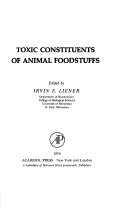
Toxic constituents of animal foodstuffs PDF
Preview Toxic constituents of animal foodstuffs
TOXIC CONSTITUENTS OF ANIMAL FOODSTUFFS FOOD SCIENCE AND TECHNOLOGY A SERIES OF MONOGRAPHS Editorial Board G. F. STEWART E. M. MRAK C. O. CHICHESTER J. K. SCOTT JOHN HAWTHORN E. VON SYDOW A. I. MORGAN Maynard A. Amerine, Rose Marie Pangborn, and Edward B. Roessler, PRINCIPLES OF SENSORY EVALUATION OF FOOD. 1965. C. R. Stumbo, THERMOBACTERIOLOGY IN FOOD PROCESSING, second edition. 1973. Gerald Reed, ENZYMES IN FOOD PROCESSING. 1966. S. M. Herschdoerfer, QUALITY CONTROL IN THE FOOD INDUSTRY. Volume I — 1967. Volume II - 1968. Volume III - 1972. Hans Riemann, FOOD-BORNE INFECTIONS AND INTOXICATIONS. 1969. Irvin E. Liener, Toxic CONSTITUENTS OF PLANT FOODSTUFFS. 1969. Martin Glicksman, GUM TECHNOLOGY IN THE FOOD INDUSTRY. 1970. L. A. Goldblatt, AFLATOXIN. 1970. Maynard A. Joslyn, METHODS IN FOOD ANALYSIS, second edition. 1970. A. C. Hulme (ed.), THE BIOCHEMISTRY OF FRUITS AND THEIR PRODUCTS. Volume 1 — 1970. Volume 2-1971. G. Ohlofr and A. F. Thomas, GUSTATION AND OLFACTION. 1971. George F. Stewart and Maynard A. Amerine, INTRODUCTION TO FOOD SCIENCE AND TECHNOLOGY. 1973. IRVIN E. LIENER (ed.), Toxic CONSTITUENTS OF ANIMAL FOODSTUFFS. 1974. AARON A. ALTSCHUL (ed.), NEW PROTEIN FOODS: TECHNOLOGY 1A. 1974. TOXIC CONSTITUENTS OF ANIMAL FOODSTUFFS Edited by IRVIN E. LIENER Department of Biochemistry College of Biological Sciences University of Minnesota St. Paul, Minnesota ® 1974 ACADEMIC PRESS New York and London A Subsidiary of Harcourt Brace Jovanovich, Publishers COPYRIGHT © 1974, BY ACADEMIC PRESS, INC. ALL RIGHTS RESERVED. NO PART OF THIS PUBLICATION MAY BE REPRODUCED OR TRANSMITTED IN ANY FORM OR BY ANY MEANS, ELECTRONIC OR MECHANICAL, INCLUDING PHOTOCOPY, RECORDING, OR ANY INFORMATION STORAGE AND RETRIEVAL SYSTEM, WITHOUT PERMISSION IN WRITING FROM THE PUBLISHER. ACADEMIC PRESS, INC. Ill Fifth Avenue, New York, New York 10003 United Kingdom Edition published by ACADEMIC PRESS, INC. (LONDON) LTD. 24/28 Oval Road, London NW1 Library of Congress Cataloging in Publication Data Liener, Irvin E Toxic constituents of animal foodstuffs. (Food science and technology) Includes bibliographies. 1. Animal food-Toxicology. 2. Food poisoning. I. Title. [DNLM: 1. Food analysis. 2. Meat- Poisoning. 3. Poultry products-Poisoning. QU50 L719t 1973 (P)] RA1259.L53 615.9'54 73-2074 ISBN 0-12-449940-6 PRINTED IN THE UNITED STATES OF AMERICA CONTENTS LIST OF CONTRIBUTORS vii PREFACE ix 1 Meat and Dairy Products Norman Sapeika I. Toxic Constituents of Meat 1 II. Toxic Constituents of Liver 11 III. Toxic Constituents of Milk 12 IV. Toxic Constituents of Cheese 23 V. Toxic Constituents of Eggs 25 VI. Atherosclerosis 26 VII. Foods Contraindicated in Certain Diseases 30 References 32 2 Avian Eggs David T. Osuga and Robert E. Feeney I. Introduction 39 II. General Composition of Egg White 41 III. Avidin—The Principal Toxic Constituent 48 IV. Lysozyme—The Bacteriolytic Agent in Egg White 55 V. Ovomucoid and Ovoinhibitor 57 VI. Ovotransferrin 60 VII. Ovoflavoprotein 63 References 65 VI Contents 3 Fish Eggs Frederick A. Fuhrman I. Introduction 74 II. Tetrodotoxin 76 III. Li pro protein Toxins 91 IV. Toxins from Eggs of Cyprinid Fishes, Pikes, and Gar 99 V. Miscellaneous 104 References 106 4 Shellfish, Fish, and Algae Edward J. Schantz I. Introduction 111 II. Fish and Shellfish Poisons Produced by Algae 112 III. Poisonous Fish 121 IV. Poisonous Algae 123 References 128 5 Nitrosamines N. P. Sen I. Introduction 132 II. Chemistry 134 III. Role of Nitrates, Nitrites, and Various Amino Compounds in the Formation of Nitrosamines in Foods 139 IV. Occurrence 152 V. Methods for Identification and Quantitative Estimation 160 VI. Biological Actions 168 VII. Other N-Nitroso Compounds 183 VIII. Possible Human Health Hazards 184 IX. Areas of Future Research 185 References 186 AUTHOR INDEX 195 SUBJECT INDEX 210 LIST OF CONTRIBUTORS Numbers in parenthesis indicate the pages on which the authors' contributions begin. ROBERT E. FEENEY (39), Department of Food Science and Tech- nology, University of California, Davis, California FREDERICK A. FUHRMAN (73), Stanford University, Hopkins Marine Station, Pacific Grove, California DAVID T. OSUGA (39), Department of Food Science and Technol- ogy, University of California, Davis, California NORMAN SAPEIKA (1), Department of Pharmacology, University of Cape Town, Observatory, Cape, South Africa. EDWARD J. SCHANTZ (111), Food Research Institute, Univer- sity of Wisconsin, Madison, Wisconsin N. P. SEN (131), Food Research Laboratories, Health Protection Branch, Department of National Health and Welfare, Ottawa, Canada. Vll This page intentionally left blank PREFACE We are living at a time when the public is becoming increasingly more concerned about the harmful effects of pollutants on the en- vironment. Most of these pollutants are chemical in nature and are generated as by-products of a highly industrialized society. Some of these, of course, gain access, in one way or another, into our food chain where they may pose a threat to our health and well being. What is sometimes not fully realized, however, is that Nature her- self has seen fit to introduce toxic substances into many of the foods which man consumes. It has been suggested that these toxic ma- terials serve as a defense mechanism for the survival of certain species of plants and animals subject to predators (Whittaker and Feeny, 1971; Leopold and Ardrey, 1972). The potentially harmful effect of such substances in plant foodstuffs consumed by man and animals has been dealt with in a book, which may be considered a companion to this one, entitled "Toxic Constituents of Plant Foods" (Liener, 1969). Examples of naturally occurring toxicants in animal tissues used as food by man, on the other hand, are few in number, if for no other reason that it makes very little evolutionary sense to expect an animal organism to be genetically endowed with the seeds of its own destruction. However, if we include food additives, pesti- cides, chemical contaminants, etc.—i.e., substances of man-made origin—foodstuffs may then become a very significant vector for the dissemination of potentially toxic agents. The subject of toxic factors in animal foodstuffs has generally been treated in a rather cursory fashion in more comprehensive treatises devoted to the general topic of naturally occurring toxi- ix
